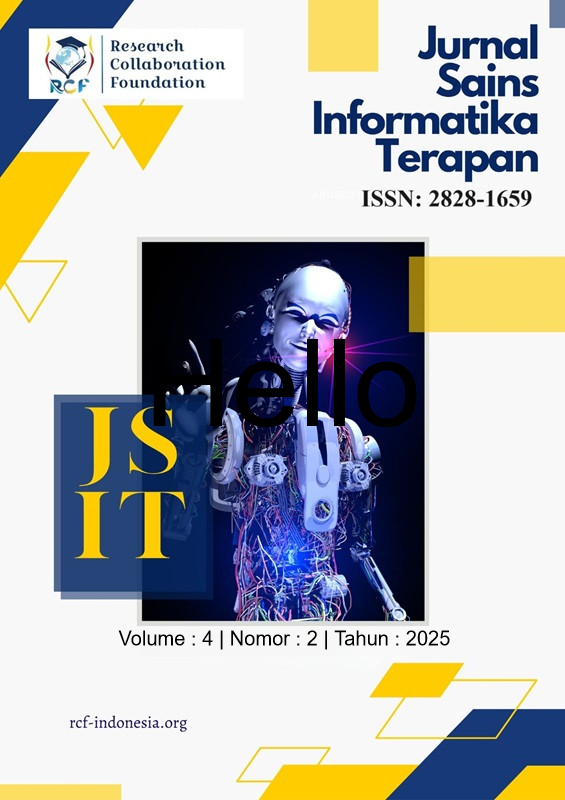Rancang Bangun Sistem Digital Pemantau Suhu dan Kelembaban Ruang Server Berbasis IoT
Main Article Content
Abstract
Server rooms require strict temperature and humidity control to ensure the stability, reliability, and longevity of electronic devices. Excessive heat or uncontrolled moisture may lead to hardware degradation, reduced system performance, and potential service interruptions. To address these challenges, this study presents the design and implementation of an IoT-based digital monitoring system that integrates an ESP32 microcontroller with a DHT22 temperature–humidity sensor. The collected data are transmitted via Wi-Fi to the ThingSpeak cloud platform, where they are stored, processed, and visualized in real time. The research method covers hardware prototyping, firmware programming, and a 24-hour continuous simulation to evaluate system performance. Experimental results indicate that the monitoring system successfully records temperature variations within the range of 22–30°C and relative humidity levels between 45–65%. When validated against a calibrated reference device, the system achieves an average measurement error of 0.6°C for temperature and 2.1% RH for humidity, which demonstrates adequate precision for server room applications. In terms of communication performance, the data upload to ThingSpeak shows an average latency of 1.2 seconds with a transmission success rate of 99%, ensuring reliable remote accessibility. Furthermore, the system is equipped with configurable alarm thresholds that provide early warnings whenever the environmental conditions exceed safe operating limits. Overall, the proposed IoT-based monitoring design proves to be a feasible, scalable, and low-cost solution for server room environments. It not only supports preventive maintenance by enabling timely detection of anomalies but also offers a practical model for extending digital monitoring to other critical facilities where environmental stability is essential.
Article Details

This work is licensed under a Creative Commons Attribution-ShareAlike 4.0 International License.
References
A. Al-Fuqaha, M. Guizani, M. Mohammadi, M. Aledhari, and M. Ayyash, “Internet of Things: A survey on enabling technologies, protocols, and applications,” IEEE Communications Surveys & Tutorials, vol. 17, no. 4, pp. 2347–2376, 2015.
Arduino, “ESP32 core for Arduino (Documentation),” 2024. [Online]. Available: https://docs.arduino.cc
Blynk Inc., “Blynk IoT Platform Documentation,” 2024. [Online]. Available: https://blynk.io
K. C. Chan and A. Singh, “Server room environmental monitoring using IoT,” Int. J. Adv. Comput. Sci., vol. 11, no. 3, pp. 45–52, 2020.
A. D’Ausilio, “Arduino: A low-cost multi-purpose lab equipment,” Behavior Research Methods, vol. 44, pp. 305–313, 2012.
Espressif Systems, “ESP32 Technical Reference Manual,” 2023. [Online]. Available: https://www.espressif.com
J. Gubbi, R. Buyya, S. Marusic, and M. Palaniswami, “Internet of Things (IoT): A vision, architectural elements, and future directions,” Future Generation Computer Systems, vol. 29, no. 7, pp. 1645–1660, 2013.
A. Higginbotham, “Temperature and humidity control in data centers,” Data Center Journal, vol. 18, no. 2, pp. 12–20, 2019.
Maxim Integrated, “DHT22 (AM2302) Humidity & Temperature Sensor Datasheet,” 2020.
MathWorks, “ThingSpeak Documentation,” 2024. [Online]. Available: https://thingspeak.mathworks.com.
A. Rahman and D. Putra, “Design of IoT-based environmental monitoring using ESP32,” J. Embedded Syst., vol. 8, no. 2, pp. 77–85, 2021.
V. J. Reddi, “Edge computing for the Internet of Things,” Synthesis Lectures on Computer Architecture, vol. 14, no. 3, pp. 1–112, 2019.
H. Suryana and R. Fadli, “Evaluasi akurasi sensor DHT22 untuk pemantauan lingkungan,” J. Syst. Inform., vol. 6, no. 1, pp. 23–30, 2022.
A. Tzounis, N. Katsoulas, T. Bartzanas, and C. Kittas, “Internet of Things in agriculture: Recent advances and future challenges,” Biosystems Engineering, vol. 164, pp. 31–48, 2017.
Y. Zhang and J. Chen, “Reliable data transmission in Wi-Fi IoT networks,” IEEE Access, vol. 8, pp. 155321–155333, 2020.
M. Ammar, G. Russello, and B. Crispo, “Internet of Things: A survey on security and privacy,” Computer Networks, vol. 148, pp. 283–294, 2019.
R. K. Kodali and S. Yerroju, “IoT-based smart data logger for environmental monitoring,” in Proc. IEEE Int. Conf. Advanced Computing and Communication Systems (ICACCS), 2020, pp. 679–683.
M. A. Hossain, M. S. Hossain, and M. Hasan, “Performance analysis of ESP32 in IoT applications,” Int. J. Comput. Appl., vol. 975, no. 8887, pp. 1–5, 2021.
S. Raza, L. Wallgren, and T. Voigt, “SVELTE: Real-time intrusion detection in the Internet of Things,” Ad Hoc Networks, vol. 11, no. 8, pp. 2661–2674, 2013.
A. Zanella, N. Bui, A. Castellani, L. Vangelista, and M. Zorzi, “Internet of Things for smart cities,” IEEE Internet of Things Journal, vol. 1, no. 1, pp. 22–32, 2014.
H. Gupta, P. K. Shukla, and S. S. Chauhan, “IoT based temperature and humidity monitoring system using DHT22 sensor and ESP32,” Int. J. Eng. Trends Technol., vol. 69, no. 8, pp. 97–102, 2021.
S. Li, L. Da Xu, and S. Zhao, “The Internet of Things: A survey,” Information Systems Frontiers, vol. 17, no. 2, pp. 243–259, 2015.
P. P. Ray, “A survey on Internet of Things architectures,” J. King Saud Univ.-Comput. Inf. Sci., vol. 30, no. 3, pp. 291–319, 2018.
S. Madakam, V. Lake, and V. Lake, “Internet of Things (IoT): A literature review,” J. Comput. Commun., vol. 3, no. 5, pp. 164–173, 2015.
M. A. Hossain, A. Rahman, and K. S. Islam, “Design and implementation of IoT based smart environmental monitoring system,” Int. J. Sci. Res. Comput. Sci. Eng. Inf. Technol., vol. 5, no. 6, pp. 450–457, 2019.

